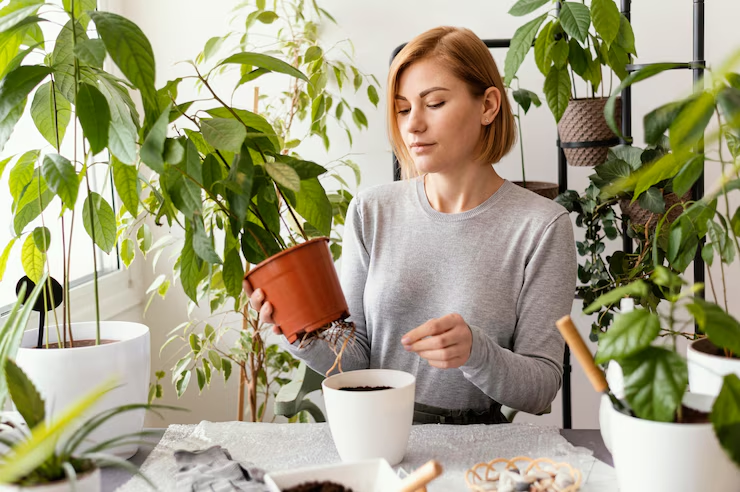How Often to Fertilize Indoor Plants
- Staff Desk
- Jun 27
- 4 min read

Fertilizing indoor plants is an essential part of keeping them vibrant, healthy, and thriving all year long. While outdoor plants benefit from natural sources of nutrients in the soil and rain, indoor plants rely almost entirely on what we provide. Yet, many plant owners are unsure about how often to fertilize, what types of fertilizers to use, and how to avoid over- or underfeeding. This guide covers everything you need to know about indoor plant fertilization—from basic schedules to plant-specific needs.
🌿 Why Fertilizing Indoor Plants Matters

Indoor plants live in a contained environment, and once the nutrients in their potting mix are used up, they need external supplementation to continue growing.
Benefits of Proper Fertilization:
Promotes healthy foliage and vibrant blooms
Encourages strong root development
Helps plants resist pests and diseases
Replenishes depleted nutrients in the soil
Over time, regular watering and plant growth deplete the nutrients in the soil, making fertilization not just beneficial, but necessary.
📊 General Fertilization Frequency Guidelines

Here’s a general rule of thumb for fertilizing most houseplants:
Plant Type | Fertilize Frequency | Notes |
Tropical Foliage Plants | Every 2–4 weeks (spring/summer) | Monthly in fall/winter |
Flowering Houseplants | Every 1–2 weeks (while blooming) | Reduce after blooming ends |
Cacti & Succulents | Every 4–6 weeks (spring/summer) | Don’t fertilize in fall/winter |
Ferns & Shade Plants | Monthly during growing season | Use diluted liquid fertilizer |
Edible Indoor Plants | Every 2–3 weeks | Choose a fertilizer specific for edibles |
Note: Always adjust based on plant health, season, and product directions.
❄️ Seasonal Fertilizing Schedule
🌻 Spring
Growth resumes, ideal time to begin feeding
Start with half-strength fertilizer and increase gradually
🌼 Summer
Peak growth season
Feed regularly, every 1–2 weeks, depending on plant type
🍂 Fall
Growth slows
Cut back to monthly or stop entirely
❄️ Winter
Dormant period for many plants
Fertilize sparingly or not at all unless plant shows active growth
💡 How to Know If Your Plant Needs Fertilizer
Signs of Nutrient Deficiency:
Pale or yellowing leaves
Slow or stunted growth
Fewer flowers or smaller leaves
Leaf drop or edge browning
Signs of Overfertilization:
Burned leaf tips (brown edges)
Salt crust on soil surface
Wilting despite moist soil
Leaf drop or curled leaves
🌱 Types of Indoor Plant Fertilizers
☕ Liquid Fertilizers
Fast-acting, easy to control
Best for regular feeding during growing season
🥜 Granular Fertilizers
Slow-release, usually mixed into soil
Great for low-maintenance feeding
🫂 Fertilizer Spikes
Inserted into soil, release nutrients over time
Convenient but less customizable
❄️ Organic Fertilizers
Made from natural sources like compost, worm castings, or fish emulsion
Promote long-term soil health and microbial activity
🔹 Understanding N-P-K Ratios
Fertilizers are labeled with 3 numbers (e.g., 10-10-10), representing:
N = Nitrogen: promotes foliage growth
P = Phosphorus: supports root growth and flowers
K = Potassium: boosts overall plant health
Common ratios:
Green foliage plants: 20-10-10
Flowering plants: 15-30-15
General-purpose: 10-10-10 or 20-20-20
🌟 Fertilizing Tips by Plant Type
🌿 Fiddle Leaf Fig
Feed monthly in spring/summer
Use balanced or nitrogen-rich fertilizer
🌸 Peace Lily
Use a bloom-boosting fertilizer every 3–4 weeks
Avoid overfertilizing to prevent root burn
🌴 Snake Plant
Feed lightly every 6 weeks during growing season
Use diluted succulent fertilizer
🪴 Pothos
Fertilize every 4 weeks with a balanced formula
Stop in winter months
🍄 Herbs (Mint, Basil, etc.)
Fertilize every 2–3 weeks with organic edible-safe feed
Avoid overfeeding, which affects taste
🥶 How to Apply Fertilizer Correctly
🥃 Liquid Feed
Mix fertilizer with water as directed
Apply to moist soil to avoid root burn
⚡ Granular Application
Sprinkle evenly on soil surface and water in
Avoid contact with plant stems and leaves
☕ Slow-Release Spikes or Pellets
Insert according to label instructions
Replace every 6–8 weeks
🚮 Common Mistakes to Avoid
Fertilizing dry soil: always moisten first
Ignoring product directions
Mixing different fertilizers at once
Overfeeding during dormancy
⌛ When to Stop Fertilizing
During winter dormancy
If a plant is stressed, recently repotted, or recovering from pests
After transplanting (wait 2–4 weeks)
If there's visible salt buildup in the soil
🏡 Indoor vs. Outdoor Plant Fertilization
Indoor plants require more careful fertilization because:
They receive less natural light and rainfall
Water does not flush nutrients as readily as in outdoor gardens
They have limited soil volume to store nutrients
This means consistency and moderation are key indoors.
🥒 Organic vs. Synthetic Fertilizers
Aspect | Organic | Synthetic |
Source | Natural (manure, compost, fish, etc.) | Chemically processed nutrients |
Release Rate | Slow and steady | Fast-acting |
Soil Health | Improves microbial life | Neutral or potentially harmful |
Odor | Can have smell | Odorless |
Cost | Usually higher | Generally more affordable |
🪷 Frequently Asked Questions
❓ Can I use the same fertilizer for all my plants?
No. Different plants have different nutritional needs. Use general-purpose fertilizer for foliage plants, and bloom-specific for flowering ones.
❓ What happens if I fertilize too often?
Overfertilizing can burn roots, cause salt buildup, and damage plants.
❓ Is compost tea good for indoor plants?
Yes! It’s a gentle organic option that enhances soil microbes and nutrients.
❓ Can I fertilize sick plants?
Only after diagnosing and stabilizing the issue. Fertilizing stressed plants may do more harm.
📝 Final Takeaway: Tailor Feeding to Your Plant's Needs
There’s no universal schedule that works for all indoor plants. Successful fertilization requires observing your plants, understanding their natural cycles, and choosing the right products.
🌟 Key Reminders:
Fertilize more in spring/summer, less in fall/winter
Always follow label instructions
Water before applying fertilizer
Avoid feeding dormant or stressed plants
By being attentive and informed, you can keep your houseplants healthy, lush, and beautiful year-round.



Comments